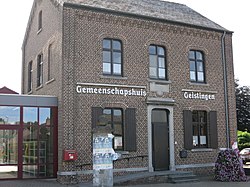Geistingen is a historic village that is now a submunicipality of Kinrooi, in the Limburg province in the Flemish Community of Belgium.
Geistingen | |
|---|---|
Village | |
 Community House | |
| Coordinates: 51°08′02″N 5°48′29″E / 51.134°N 5.808°E | |
| Country | |
| Region | |
| Province | |
| Arrondissement | Maaseik |
| Municipality | Kinrooi |
| Area | |
• Total | 4.89 km2 (1.89 sq mi) |
| Population (2021)[1] | |
• Total | 1,088 |
| • Density | 220/km2 (580/sq mi) |
| Time zone | CET |
History
editIn the 1st and 2nd century, a Roman camp was located in Geistingen, and the parish of Geistingen has existed since the 8th century. The village was located on the Roman road connecting Maastricht and Nijmegen At that time, it lay close to the river Meuse. The Meuse in the meanwhile had changed its course to the east.[2] In the 15th century, Ophoven developed next to Geistingen, and the municipality was referred to as Ophoven-Geistingen.[3] In 1450, both villages became part of the county of Horne. In 1614, Horne ceased to be independent and became part of the Prince-Bishopric of Liège.[4] In 1971, the municipality of Ophoven-Geistingen merged into Kinrooi.[5]
Gallery
edit-
Spaanjerdplas
-
Community house
Notable people
edit- Martin-Hubert Rutten (1841–1927), bishop.[6]
References
edit- ^ a b "Bevolking per statistische sector - Sector 72018D1". Statistics Belgium. Retrieved 6 May 2022.
- ^ "Geistingen". Agentschap Onroerend Erfgoed. Retrieved 18 October 2020.
- ^ "Ophoven". Agentschap Onroerend Erfgoed. Retrieved 18 October 2020.
- ^ "GESCHIEDENIS HORN". Heemkunde Horn (in Dutch). Retrieved 18 October 2020.
- ^ "Nieuwe naam voor de gemeente". Kinrooi meemaken (in Dutch). Retrieved 18 October 2020.
- ^ "Bloc-Notes BC 9623" (PDF). Trésor de Liège (in French). Retrieved 18 October 2020.
External links
editMedia related to Geistingen at Wikimedia Commons
